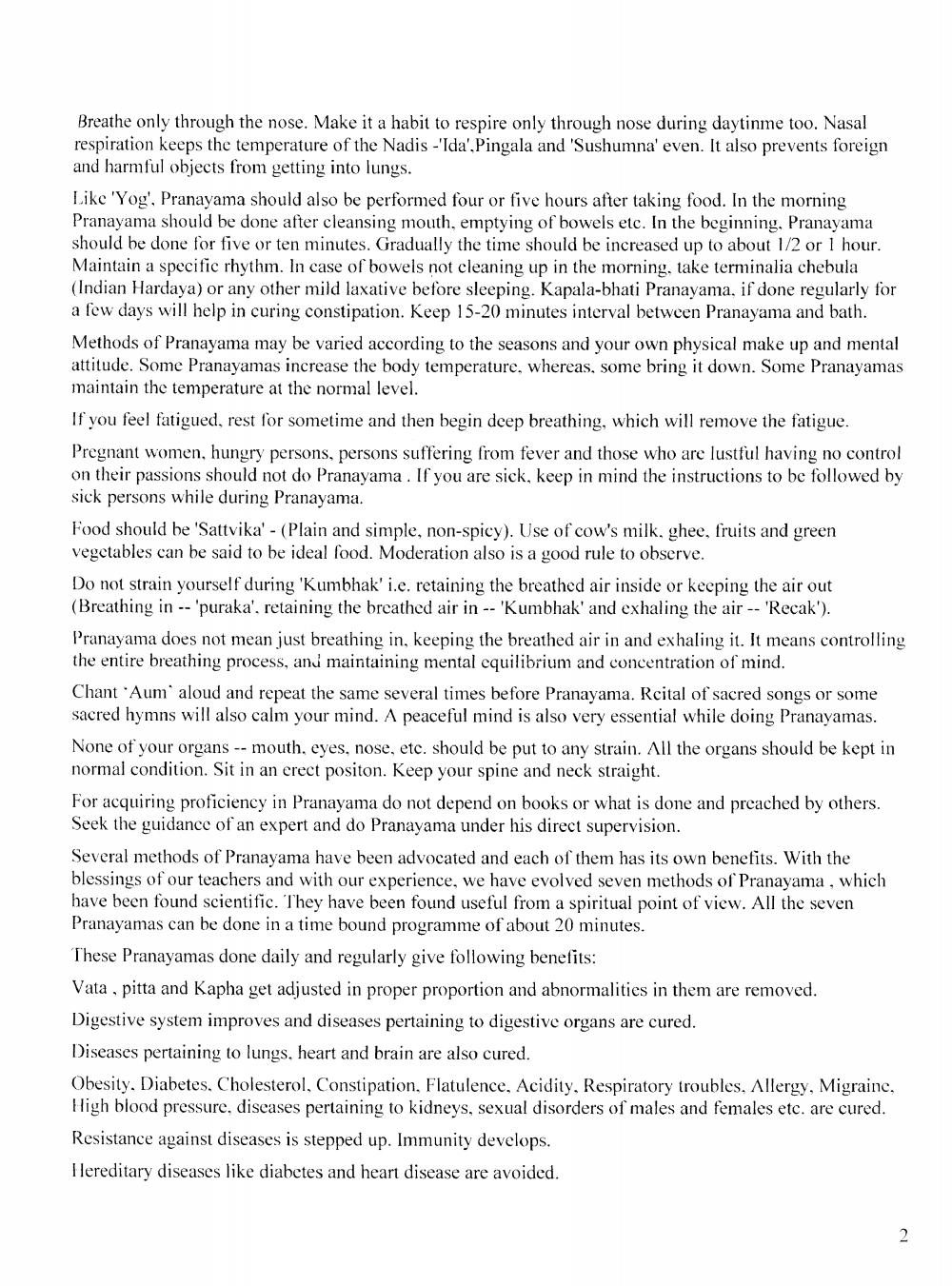Book Title: Importance of Pranayam and Its Benefits Author(s): Publisher: ZZZ Unknown View full book textPage 2
________________ Breathe only through the nose. Make it a habit to respire only through nose during daytinme too. Nasal respiration keeps the temperature of the Nadis -'Ida', Pingala and 'Sushumna' even. It also prevents foreign and harmful objects from getting into lungs. Like 'Yog'. Pranayama should also be performed four or five hours after taking food. In the morning Pranayama should be done after cleansing mouth, emptying of bowels etc. In the beginning, Pranayama should be done for five or ten minutes. Gradually the time should be increased up to about 1/2 or 1 hour. Maintain a specific rhythm. In case of bowels not cleaning up in the morning, take terminalia chebula (Indian Hardaya) or any other mild laxative before sleeping. Kapala-bhati Pranayama, if done regularly for a few days will help in curing constipation. Keep 15-20 minutes interval between Pranayama and bath. Methods of Pranayama may be varied according to the seasons and your own physical make up and mental attitude. Some Pranayamas increase the body temperature, whereas, some bring it down. Some Pranayamas maintain the temperature at the normal level. If you feel fatigued, rest for sometime and then begin deep breathing, which will remove the fatigue. Pregnant women, hungry persons, persons suffering from fever and those who are lustful having no control on their passions should not do Pranayama. If you are sick, keep in mind the instructions to be followed by sick persons while during Pranayama. Food should be 'Sattvika' - (Plain and simple, non-spicy). Use of cow's milk, ghee, fruits and green vegetables can be said to be ideal food. Moderation also is a good rule to observe. Do not strain yourself during 'Kumbhak' i.e. retaining the breathed air inside or keeping the air out (Breathing in -- 'puraka', retaining the breathed air in -- 'Kumbhak' and exhaling the air -- 'Recak'). Pranayama does not mean just breathing in, keeping the breathed air in and exhaling it. It means controlling the entire breathing process, and maintaining mental cquilibrium and concentration of mind. Chant Aum aloud and repeat the same several times before Pranayama. Rcital of sacred songs or some sacred hymns will also calm your mind. A peaceful mind is also very essential while doing Pranayamas. None of your organs -- mouth, eyes, nose, etc. should be put to any strain. All the organs should be kept in normal condition. Sit in an erect positon. Keep your spine and neck straight. For acquiring proficiency in Pranayama do not depend on books or what is done and preached by others. Seek the guidance of an expert and do Pranayama under his direct supervision. Several methods of Pranayama have been advocated and each of them has its own benefits. With the blessings of our teachers and with our experience, we have evolved seven methods of Pranayama, which have been found scientific. They have been found useful from a spiritual point of view. All the seven Pranayamas can be done in a time bound programme of about 20 minutes. These Pranayamas done daily and regularly give following benefits: Vata , pitta and Kapha get adjusted in proper proportion and abnormalities in them are removed. Digestive system improves and diseases pertaining to digestive organs are cured. Diseases pertaining to lungs, heart and brain are also cured. Obesity, Diabetes, Cholesterol, Constipation, Flatulence. Acidity, Respiratory troubles, Allergy, Migraine, High blood pressure, diseases pertaining to kidneys, sexual disorders of males and females etc. are cured. Resistance against diseases is stepped up. Immunity develops. Hereditary diseases like diabetes and heart disease are avoided.Page Navigation
1 2 3 4 5
